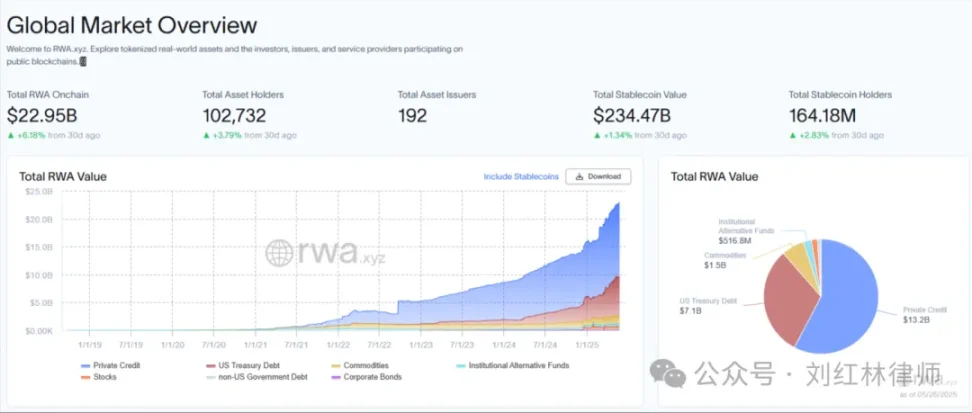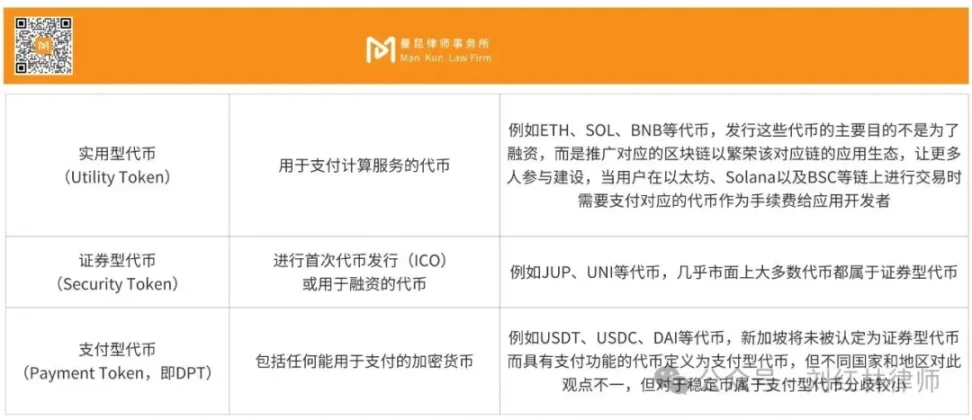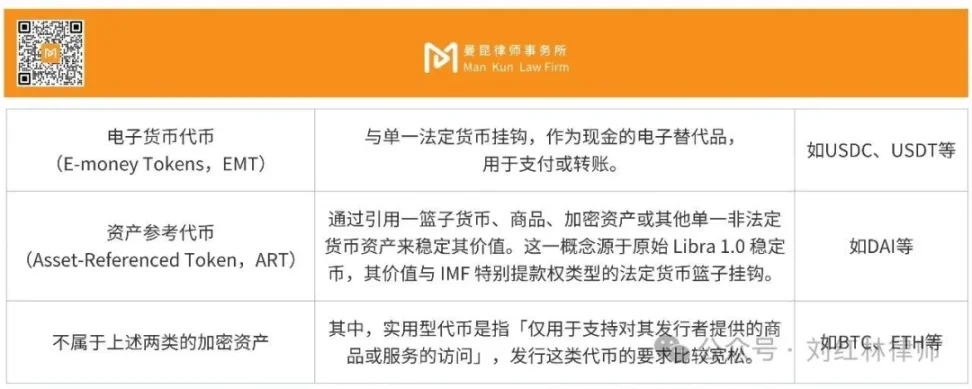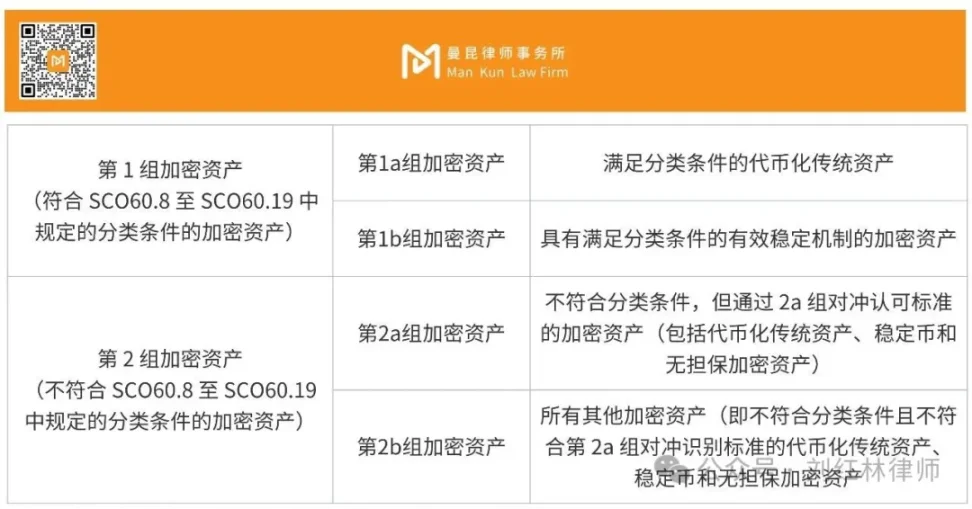The draft for stablecoins in Hong Kong, the GENIUS in the United States, the MiCA in Europe, and the passing of legislation in Southeast Asia undoubtedly represent a significant advancement in the application layer of RWA.
Authors: Li Zhongzheng, Song Zeting
What is RWA?
RWA (Real World Assets) refers to the tokenization of real-world physical assets (such as real estate, gold, art, etc.) or property rights (such as debts, income rights, fund shares, etc.) into digital tokens that can circulate on the blockchain. It achieves an innovative model of asset fragmentation, public ledgers, free circulation, and automated management. Its technological foundation relies on the immutability of blockchain and the automatic execution capabilities of smart contracts, and it requires legal assurance of the consistency between on-chain rights and underlying asset ownership. In simple terms, RWA is very similar to asset securitization in traditional finance, but it is more innovative and flexible.

For example, suppose you own a house worth 3 million yuan. If you want to sell it in reality, you might need to list it with real estate agents and platforms like Anjuke, and for a period, you would have to show the house to multiple potential buyers and negotiate prices. After finally finding a buyer, you would sell the entire house to them, who would need to pay the full amount. This process has a long transaction cycle and is quite complex. However, if you convert this house into a digital token that can circulate on the blockchain—let's call it "house"—you could divide the ownership of this 3 million yuan house into 30,000 house tokens, each worth 100 yuan, meaning each house token represents one-thirtieth of the ownership of the house. This way, anyone could buy one-thirtieth of the ownership of the property for just 100 yuan and could freely buy and sell these tokens at any time—this is RWA.
However, we all know that in mainland China, changing real estate property rights requires going to the real estate registration center to handle the transfer. If, as in the example above, you were to issue house tokens on-chain, would buying this house token grant you the corresponding property rights? Clearly not, as this is in direct conflict with our country's laws.
In fact, the core of RWA is not to move the asset itself onto the chain (you can't move a house or equity), but to tokenize the "proof of ownership of the asset"—for example, converting legally recognized rights certificates such as stocks, bonds, and property certificates into tokens on the chain. The essence of the asset is "rights," and the carrier of rights is "legally recognized certificates." What RWA aims to do is to repackage these "legally protected certificates" using blockchain technology, making the circulation of certificates more efficient and transparent, but the prerequisite is: rights under a legal framework must exist before there can be tokens on the chain.
Of course, from this, we can see that the first step of RWA is tokenization—issuing RWA project tokens.
Securitization of RWA Tokens
(1) Classification of Tokens
When discussing the securitization of RWA tokens, it is essential to first understand the classification of cryptocurrencies. However, since countries, regions, and organizations around the world have not reached a unified classification standard, the classification of cryptocurrencies is still in a chaotic state. Below are the approximate classifications of cryptocurrencies in various regions globally:
- Hong Kong
The Hong Kong Securities and Futures Commission (SFC) has classified tokens into security tokens and non-security tokens in conjunction with the Hong Kong Monetary Authority. Security tokens are regulated under the Securities and Futures Ordinance, while non-security tokens fall under the Anti-Money Laundering Ordinance.
- Singapore
The Monetary Authority of Singapore (MAS) classifies cryptocurrencies into three categories: utility tokens, security tokens, and payment tokens. However, on March 27, 2025, MAS released a "Consultation Paper on the Prudential Treatment of Cryptoasset Exposures and Requirements for Additional Tier 1 and Tier 2 Capital Instruments for Banks," intending to align the classification of crypto assets with Basel standards.

- United States
The United States classifies tokens as commodities and securities but has not provided a more detailed classification of cryptocurrencies. The Commodity Futures Trading Commission (CFTC) has explicitly classified Bitcoin and Ethereum as commodities, while the Securities and Exchange Commission (SEC) uses the "Howey Test" to determine whether an asset is a security. However, there is a regulatory conflict between the SEC and CFTC regarding whether cryptocurrencies are "securities" or "commodities."
The Howey Test is the legal standard used by the SEC and courts to determine whether a transaction constitutes a "security" (specifically an "investment contract").
According to the Howey Test, if a transaction meets the following four conditions, it is considered a "security" and must comply with U.S. securities laws:
a) One party invests
b) The investment is in a common enterprise
c) The investment is expected to generate profits
d) The profits come from the efforts of the issuer or a third party
In 2019, the SEC ruled that Bitcoin did not pass the Howey Test. According to the ruling, Bitcoin only met the first requirement of the framework, which is that there must be an investment of funds. However, since there is no central company controlling Bitcoin, the SEC ruled that Bitcoin does not meet the other requirements of the Howey Test: investors are not pooling their funds in a "common enterprise," and Bitcoin's value does not depend on a third party (i.e., product developers).
- European Union
The EU's Markets in Crypto-Assets (MiCA) regulation classifies crypto assets into electronic money tokens, asset-referenced tokens, and other crypto assets. Notably, the EU divides what we commonly refer to as stablecoins into two categories: electronic money tokens and asset-referenced tokens.

- Basel Committee
The Basel Committee on Banking Supervision (BCBS) is the main global standard setter for banking prudential regulation and provides a platform for regular cooperation on banking supervisory matters. Its 45 members include central banks and banking supervisory authorities from 28 jurisdictions. The Basel framework published by the BCBS is a complete set of standards, and BCBS members have agreed to fully implement these standards and apply them to internationally active banks within their jurisdictions. The SCO60 published by BCBS classifies crypto assets into the following categories:

(2) Why Securitize RWA Tokens?
As mentioned earlier, although there is no unified standard for the classification of tokens in major regions globally, there is a classification for security tokens in Hong Kong, Singapore, and the United States.
So the question arises, which type does the RWA token belong to?
In fact, the classification of RWA tokens should be based on the real-world assets they represent:
A small number of RWA tokens belong to non-security tokens. For example, USDT and USDC, which dominate the stablecoin market, are products that tokenize the real-world asset of the U.S. dollar. It can be said that USDT and USDC also belong to RWA, but they certainly do not belong to security tokens.
Most RWA tokens belong to security tokens. For example, BlackRock's tokenized fund BUIDL, if you invest 1,000 USD in the BUIDL fund, the fund promises to provide a stable value of 1 USD per token while helping holders manage their investments to earn returns.
Since most RWA tokens may belong to security tokens, they must be securitized (recognized as securities), which means these RWA tokens must comply with the regulatory policies for securities in their circulation areas. Otherwise, if deemed non-compliant, they could face hefty fines or even criminal risks.
Global Regulatory Landscape for RWA Tokens
Currently, there are no specific regulatory policies targeting RWA tokens; RWA tokens essentially fall under the category of crypto assets, and their regulation still applies to the regulatory policies and laws for crypto assets in various regions.
(1) Hong Kong
The regulatory draft for RWA stable tokens in Hong Kong was officially passed on May 21, 2025, and it delves into eight key points regarding the compliance framework and regulatory possibilities for RWA stable tokens:
Licensing system and entry thresholds
Reserve asset requirements
Transparency and information disclosure
Anti-money laundering and counter-terrorism financing
Legal enforcement authority of regulatory agencies
Cross-border coordination and enforcement authority
Investor protection mechanisms
Technological advancement and sustainable regulation
According to the "Stablecoin Bill," any entity wishing to engage in the issuance, promotion, or related activities of fiat stablecoins in Hong Kong must meet specific conditions. For example, a license issued by the Hong Kong Monetary Authority, the company's qualifications, the purpose of issuing tokens, and public scrutiny and anti-money laundering measures, as well as ongoing supervision after licensing. Potential conflict points and balances, such as the contradiction between innovation and regulation, need to be noted. It is important to recognize that if the regulatory licensing requirements are too high, they may hinder market innovation.
The reserve asset requirements mainly focus on whether the licensee possesses "high-quality and highly liquid assets." For example, cash, short-term government bonds, repurchase agreements, and other cash-like assets. These assets have two core characteristics—low volatility and high liquidity, allowing them to be quickly converted into cash during market fluctuations or large-scale redemptions, maintaining a fixed exchange rate between the stablecoin and the pegged asset. According to the Stored Value Payment Instruments License (SVF), licensed institutions must pay a deposit of 25 million HKD or 5% of their asset size. We can also refer to this for the licensing standards for stablecoins. For instance, if one wishes to issue 10 billion HKD in stablecoins, the reserve assets must be ≥10 billion HKD in fiat currency to ensure that the stablecoin can be redeemed at face value at any time and to mitigate redemption risks.
The transparency of stablecoins and the disclosure of information are crucial aspects for market safety and building market confidence. From a traditional finance perspective, investor confidence in a trading market determines the efficiency and capacity of that market. This is why publicly listed companies in the stock market are required to disclose certain operational information, such as revenue, on a quarterly and annual basis (for example, the SEC requires disclosures like 10K, 10Q, 8K, 13F, etc.). This ensures that investors have greater trust in the market and guarantees the certainty and safety of their funds.
Another apparent issue raised in the draft is that stablecoins, due to their anonymity and cross-border liquidity, may be exploited by criminals as tools for money laundering and terrorist financing. To address this, a set of targeted rules is being developed to ensure that stablecoin transactions are legal and transparent, with identity verification (KYC), fund tracing, and record-keeping being the three key elements of this issue. The draft indicates that Hong Kong plans to further align with international standards (such as the FATF's "Guidance on Virtual Assets"). As long as the transparency of funds and reasonable privacy are guaranteed, this issue can be resolved.
Additionally, the "Stablecoin Bill" grants the Financial Commissioner (Hong Kong Monetary Authority) strong legal enforcement powers to ensure the compliant operation of the stablecoin market. For example, if there is suspicion that a stablecoin issuer has misappropriated reserve assets, the authority can directly access their financial records and transaction data. If necessary, third-party organizations (such as accounting firms) can be appointed to assist in investigations, and even international expert teams can be hired to dismantle cross-border money laundering chains.
In the context of globalization, Hong Kong's "Stablecoin Bill" has established a global regulatory network through cross-border coordination mechanisms and strong enforcement powers, ensuring that the issuance and trading of stablecoins are legal and compliant. For instance, if an overseas stablecoin issuer is suspected of money laundering, the Hong Kong Monetary Authority can request local regulatory agencies to assist in the investigation (commonly referred to as "distant fishing"). By obtaining regulatory authority over foreign entities, emergency disposal rights, and the cross-border applicability of criminal and civil sanctions, a pathway is paved for the compliant globalization of stablecoins.
In summary, after the passage of this draft, a "firewall" for investor protection has been constructed based on six mechanisms: standardized entry screening, risk isolation, transparent disclosure, tiered sales, rapid compensation, and strict penalties for violations. The core logic is:
Before: Strictly control the qualifications of issuers to eliminate "empty-handed wolves";
During: Enforce transparency in operations to prevent opaque practices;
After: Provide relief channels to reduce the cost of rights protection.
This framework not only lays a compliant foundation for Hong Kong's stablecoin market but also sets a benchmark for global investor protection—ensuring that while embracing innovation, "retail wallets" are not eroded by financial risk-taking behaviors. A framework for severe penalties and enforcement has been established; for instance, unlicensed issuance or false advertising, or fraudulent behavior, could result in fines of 5 million HKD and a 7-year prison sentence, with a maximum fine of 10 million HKD and 10 years of imprisonment.
In the future, Hong Kong may further explore embedding compliance rules into smart contracts, utilizing blockchain technology to achieve automated regulation while meeting regulatory requirements under the premise of protecting user privacy. With "controllable risks and orderly innovation" as the core, it injects compliance genes into Hong Kong's virtual asset ecosystem and contributes Eastern wisdom to global financial governance. While safeguarding the bottom line of safety, Hong Kong is welcoming the future of financial technology with an open posture, striving to become a "super connector" for virtual asset regulation and innovation.
(2) The U.S. GENIUS Act
On May 19, 2025, the U.S. Senate passed the procedural vote for the "Guiding and Establishing National Innovation for U.S. Stablecoins Act" with a vote of 66 in favor and 32 against. The bill mentions precise definitions for stablecoins, who can issue them, and the requirements for issuance. One of the most concerning points is the funding reserve requirements for stablecoins.
The bill states that U.S. legal stablecoins must have 100% reserves for the amount of stablecoins issued, and these reserves must be in cash or cash-equivalent assets or short-term bills and CDs with liquidity. Additionally, these reserves must be audited and disclosed regularly. Each stablecoin issuer will have 18 months to adjust liquidity to comply with the new laws and regulations. So far, the stablecoin named USD1 traded on platforms is in full compliance.
The GENIUS Act also mentions that algorithmic stablecoins will gradually fade out, and some will be banned. Due to the death spiral incident of Terra/Luna in 2022, which exposed the fatal flaws and unstable nature of algorithmic stablecoins, stricter legal controls are needed to ensure that similar incidents do not occur again. The bill also strengthens anti-money laundering (AML) measures and addresses various concerns, prohibiting U.S. government officials from issuing stablecoins. This ensures legal backing for Web 3.0 and ongoing educational efforts to reduce fraud, money laundering, cybersecurity risks, and other criminal activities.
(3) Singapore
On January 14, 2019, Singapore passed the "Payment Services Act (PSA) 2019" and has been continuously amending it as a "forward-looking and flexible framework for regulating Singapore's payment systems and payment service providers." This act replaced the previous "Payment Systems Oversight Act" and "Money-Changing and Remittance Businesses Act." Additionally, the Monetary Authority of Singapore (MAS) issued notice PSN01 (Preventing Money Laundering and Combating Terrorist Financing—Designated Payment Services) under the PSA, introducing anti-money laundering (AML) and combating the financing of terrorism (CFT) requirements for regulated payment service providers. This means that payment service providers must implement the following measures to achieve regulatory compliance:
Risk assessment and risk mitigation
Customer due diligence
Reliance on third parties
Agency accounts and wire transfers
Record-keeping
Reporting suspicious transactions
Internal policies, compliance, audits, and training
On March 27, 2025, the Monetary Authority of Singapore released the "Consultation Paper on the Prudential Treatment of Cryptoasset Exposures and Requirements for Additional Tier 1 and Tier 2 Capital Instruments for Banks," aimed at implementing updated prudential treatment and disclosure standards for crypto asset risks by the Basel Committee on Banking Supervision (BCBS). It mentions that crypto assets meeting all classification criteria are categorized as Group 1a crypto assets (tokenized versions of traditional assets) or Group 1b crypto assets (crypto assets intended to redeem pegged values, where the pegged value is a predefined reference asset or the value of an asset with an effective stabilization mechanism).
For crypto assets classified as Group 1b, the BCBS has stipulated redemption risk testing for the prudent treatment of crypto asset risk exposures, aiming to ensure that reserve assets are sufficient for the crypto assets to be redeemable at any time at their pegged value. To pass the redemption risk test, banks must ensure that the reserve assets for crypto assets meet conditions related to the value and composition of the reserve assets and the management of those reserve assets.
(4) European Union
In June 2023, the European Union officially released the "Markets in Crypto-Assets Regulation" (MiCA), which categorizes its regulatory targets into two types:
1) The first category includes crypto asset issuers, including stablecoin issuers and other cryptocurrency issuers.
MiCA has the following main requirements for stablecoin issuers:
Obtain authorization before issuance
Fulfill disclosure obligations
Hold a certain scale of own funds and reserve assets
MiCA has more lenient requirements for other crypto asset issuers:
Issuers must establish a legal entity within the EU
Publish a white paper
2) The second category of regulatory targets is crypto asset service providers. MiCA's requirements for crypto asset service providers mainly include four aspects:
Obtain authorization
Establish a sound governance structure
Meet minimum capital requirements
Consumer protection and transparency requirements
Potential Issues in RWA Practice Beyond Legalities
The passing of the stablecoin draft in Hong Kong, the U.S. GENIUS Act, the MiCA in Europe, and legislation in Southeast Asia undoubtedly represents a significant advancement in the application layer of RWA. However, beyond legal regulations, there are potential issues that cannot be resolved solely through regulation. For instance, the liquidity of RWA on major centralized trading platforms and the need for RWA Web 3.0 anti-fraud education. These issues are not weaknesses of RWA but rather uncertainties that can only be addressed over time.
As attention focuses on improving the legal framework, RWA still faces multiple hidden challenges in practice, and its development trajectory may resemble a "marathon" rather than a "sprint."
(1) Liquidity Dilemma: The "False Proposition" of Centralized Platforms
Currently, the liquidity of RWA on centralized trading platforms (CEX) and the assets tied to them in traditional financial exchanges shows a clear polarization. Taking Hong Kong as an example, although the issuance of compliance licenses has accelerated institutional capital entry, some funds, such as BlackRock's BUIDL U.S. Treasury token, show significantly insufficient daily liquidity. This theoretical and practical disconnect stems from the heterogeneity of RWA assets: securitized tokens require a relatively emerging and complex custody and clearing system. More critically, the liquidity premium mechanism of traditional financial markets has not fully migrated to the blockchain, and the same commercial real estate token may be repeatedly mortgaged across multiple platforms, while the delayed synchronization between off-chain registration systems and on-chain data makes it difficult for arbitrageurs to bridge price gaps.
(2) Educational Gap: Cognitive Discrepancies Between Web3 Natives and the Real World
The complexity of anti-fraud education far exceeds simple risk warnings. In many legalized regions, Web3 users, such as certain investors in Singapore, misunderstand "RWA" as a new type of stablecoin, while European pension fund investors compare RWA tokenized bonds with the yields of traditional ABS products. This cognitive bias has given rise to new forms of fraud. For example, a project may forge a government digital signature to package its bonds as "central bank-backed" RWA tokens, illegally raising funds in decentralized forums. The information disclosure templates required by regulatory agencies are difficult to cover such targeted frauds stemming from technological cognitive differences.
(3) Technical Debt: Underestimated Off-Chain and On-Chain Coordination Costs
Existing RWA solutions generally fall into the "oracle paradox." For instance, when a trust synchronizes rental income through the Chainlink oracle, node operators may require dual audit reports for both on-chain and off-chain. This hybrid architecture leads to increasing marginal costs. A European railway asset tokenization project was forced to postpone an 800 million euro asset migration plan due to security disputes over cross-chain bridges between Polkadot and Cosmos. These issues undoubtedly exceed the wear and risks that would not have existed under the traditional financial system. Given the complexity of the architecture and the current problems exceeding those of traditional structures, what solutions or incentives would encourage people to use the RWA token system?
Addressing these deep-seated contradictions requires transcending purely technical or regulatory dimensions: on the liquidity front, a "custody + oracle" dual-track system could be discussed, allowing traditional custodians to issue digital ownership certificates on-chain, as seen with Ondo Finance and its series of product solutions. In terms of educational outreach, the RWA sandbox simulator launched by Hong Kong's Cyberport has begun to use a gamified interface to showcase the full process risk nodes of asset tokenization. The true maturity of RWA may give rise to a "third infrastructure" that bridges traditional finance and crypto-ideology. While the market eagerly discusses the milestone of RWA market capitalization surpassing 50 billion USD, perhaps more attention should be paid to those hidden costs not accounted for in financial reports. These undercurrents remind us that the evolution speed of RWA ultimately depends on the efficiency of the integration between the real world and the digital native ecosystem, which is destined to be a long-term game requiring patience and wisdom.
免责声明:本文章仅代表作者个人观点,不代表本平台的立场和观点。本文章仅供信息分享,不构成对任何人的任何投资建议。用户与作者之间的任何争议,与本平台无关。如网页中刊载的文章或图片涉及侵权,请提供相关的权利证明和身份证明发送邮件到support@aicoin.com,本平台相关工作人员将会进行核查。




